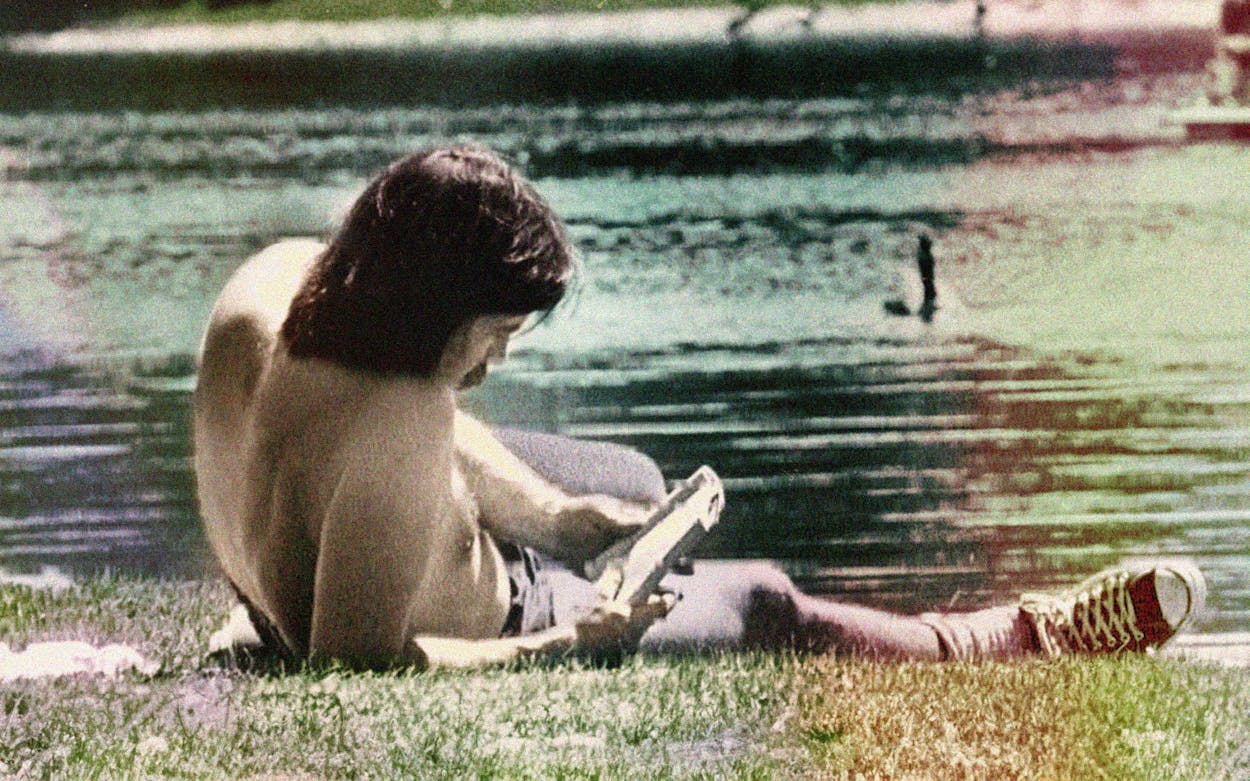On a camping trip to Inks Lake State Park, just north of Austin, a few months ago, I soaked up an hour of perfect contentment. As darkness fell, cicadas began to buzz and the occasional swallow flitted over our waterfront campsite. I strung my hammock up between two trees and curled up inside with a beer and a novel. My husband and our son were soon snoring softly in the tent, all of us pleasantly worn out from a day of hiking and swimming in the Devil’s Waterhole. Sleep beckoned me, too, though it wasn’t even 10 p.m. First, though, I cracked open the long, meandering family saga I was halfway through and lost myself in its fictional world.
At home, my attention is fractured by the temptation to scroll on social media, stream a TV show, or turn to any of the myriad other distractions pinging around. In a state park, there’s a good chance I won’t have any cell signal, and reading is one of very few options for what to do after dark. Somehow stories seem sharper, their characters more captivating, in the beam of a headlamp than on the couch. And if staying overnight isn’t your thing, you can still indulge in the delights of a picnic lunch and reading session, or a lazy beach day spent turning pages under an umbrella. Losing yourself in a tale set thousands of miles away is one way to do it. Or you can go the opposite route and select a book that matches the vibe or geographic setting. That’s what we’ve recommended in the list below: five book-and-park pairings that, as with a thoughtful wine-and-cheese combo, will enhance the flavor of both components.
The Park: Big Bend National Park
The Book: The Which Way Tree, by Elizabeth Crook
Since it’s set in the Hill Country, not West Texas, this book might initially seem an odd choice for a trip to Big Bend. But it’s actually a perfect fit, because it’s all about a hunt for the park’s most famous resident: a mountain lion. Austin author Crook’s fast-paced frontier saga, which a Texas Monthly reviewer called “gripping” and “deceptively simple,” follows heroine Samantha as she hunts down the lion that killed her mother. In the Civil War era, when the novel takes place, the predators roamed much of the state; now they’re found only in West Texas. Putting a fresh, feminist spin on Western tropes, the story takes unexpected turns and delves into the question of what revenge really means. You might tremble a little if you read in your tent at night, wondering if a real mountain lion is pacing just outside.
The Park: Caddo Lake State Park, Karnack
The Book: Heaven, My Home, by Attica Locke
Caddo Lake is the state’s best setting for a murder mystery. Eerie curtains of Spanish moss hang over the water, things unseen stir in the shadows (including alligators and paddlefish, a primordial species older than dinosaurs), and the ghostly white trunks of bald cypresses stand watch over canoers and campers. Locke now lives in Los Angeles, where she writes for film and TV, but she grew up in the region and spent many a summer day exploring Caddo Lake with her family. She brings a screenwriter’s knack for breathless pacing and twisty plots to Heaven, My Home, the second in her detective series following Texas Ranger Darren Mathews.
The Park: Estero Llano Grande State Park, Weslaco
The Book: With the River on Our Face, by Emmy Pérez
An internationally acclaimed birding destination and part of the World Birding Center, Estero Llano Grande in Weslaco fills up in the winter with seekers of such tropical quarry as the green jay, the red-crowned parrot, and the Altamira oriole. The vivid verse of Emmy Pérez, a former Texas poet laureate who lives in McAllen, observes small moments and flashes of color with a keen eye. “Neon green anole / swells its throat / pink-white,” she writes in the poem that lends the book its title, listing other animals and natural phenomena before shifting to “The young border patrol officer” who “flashes sirens daily.”
The Park: Galveston Island State Park
The Book: The Last Karankawas, by Kimberly Garza
A boisterous chorus of Mexican American and Filipino American voices narrate this book, which is either a novel or a linked collection of short stories, depending whom you ask. It’s set in the real neighborhood of Fish Village—a diverse community so named because it consists of such streets as Tuna Avenue and Barracuda Drive—in 2008, as Hurricane Ike closes in on the island. Rather than spinning a plot-driven tale, Garza (who was born on the island—BOI, as the lingo goes) evokes a mood that you might recognize if you’ve spent much time in Galveston. The weather is salt-tinged and humid, the characters weary but resilient, and the overheated afternoons long and languid. This is a book you can dip in and out of easily, in between swimming or strolling on the sand.
The Park: Palo Duro Canyon State Park, Canyon
The Book: Georgia O’Keeffe’s Wartime Texas Letters, by Amy Von Lintel
Watching a sunset over the walls of Palo Duro Canyon, when the evening light paints the rocks in warm, soft shades of orange and gold, always makes me feel contemplative. The sight had a similar effect on Georgia O’Keeffe, who lived in the area as a twenty-something artist finding her way. A prolific writer, she penned hundreds of letters to friends and family on the East Coast, and her breathless, evocative voice is something to behold. “In the wind my black close hat brim is like a flickering shadow between me and the gold of the plains that stretches seemingly to never,” goes one typical line. She was forever marveling at the harsh Panhandle landscape: “The wonderful stretch of the bare line at sunset—the stars—a train that I watched like a star on the horizon.” (Lest you think O’Keeffe did nothing in Texas but stare solemnly out her window, rest assured that she also “danced, went to movies, rode with men in fast cars . . . and kissed a lot of guys,” writes Texas Monthly’s Molly Glentzer.) The book includes some of her paintings, which you’ll see in a new way after reading the letters; others are on display at the Panhandle-Plains Historical Museum, in Canyon, just a short drive from the park, and well worth the visit.
- More About:
- Books








